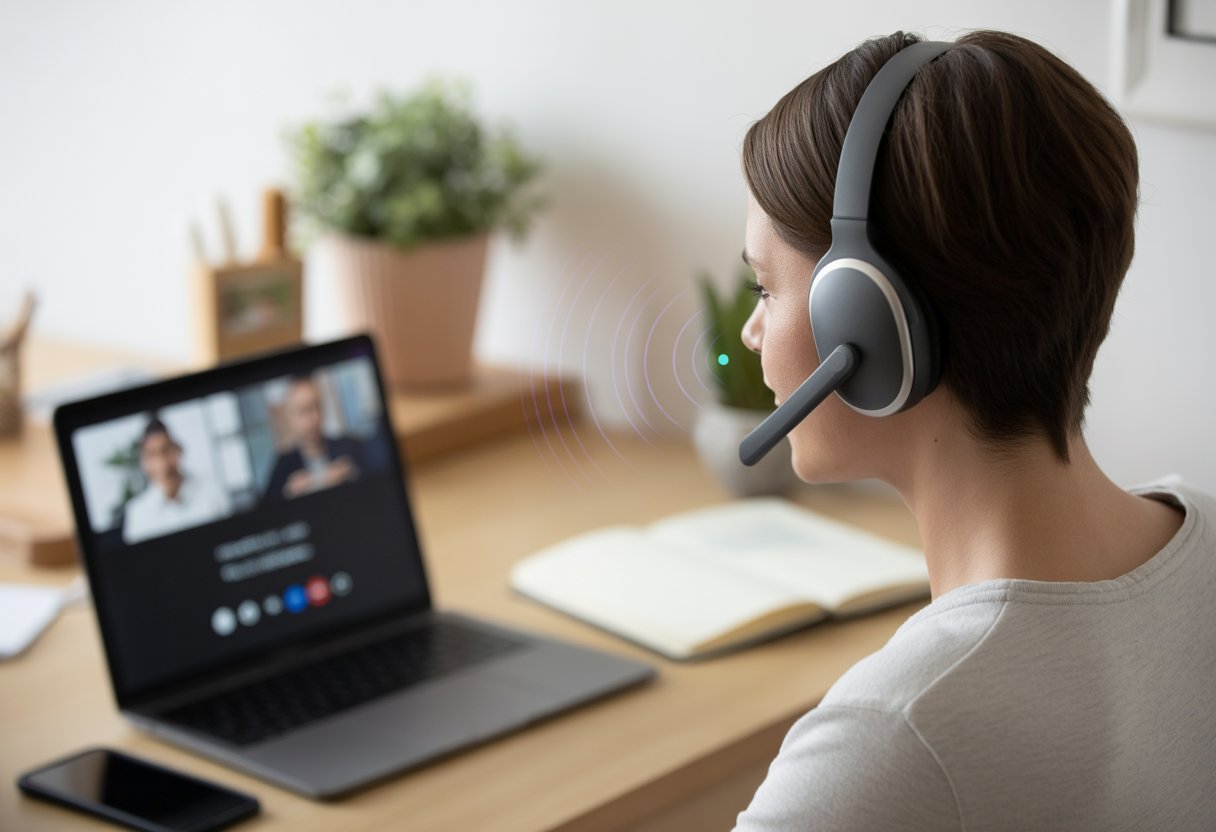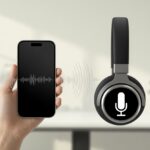Let’s be honest: tangled headphone cords have probably spilled more coffee and ruined more moments of dignity than anything else during conference calls. Thankfully, we can now wander, stretch, and pace around the room without dragging our laptops off the table. Using Bluetooth headphones for conference calls just means pairing them with your device and picking them for audio during the call. Even the most tech-phobic team member can usually figure it out.

Bluetooth headphones let us move around and keep our conversations private, so we’re not blasting awkward small talk to everyone nearby. Just connect, check the audio settings in the meeting app, and jump into the call.
If anything goes sideways, we can check the settings or skim a guide like this one from Sony. That usually fixes things.
Having a good setup means more than just hands-free calls. We can stop miming “can you hear me now?” while coworkers look on in horror.
Let’s get our Bluetooth headphones ready and make the next call a little more fun (and a lot less tangled).
Choosing the Right Bluetooth Headphones for Conference Calls
Picking the right Bluetooth headphones for work calls can save us from background chaos and ear pain. The right choice keeps us sounding clear and comfortable.
Identifying Essential Features
Before we hit “add to cart” in a late-night shopping spree, let’s think about what matters most. Battery life is huge, especially if meetings tend to drag on.
Nobody wants to say, “Sorry, my headphones died,” for the third time this week.
Easy Bluetooth pairing saves us from button-mashing frustration. A built-in mic with a mute button is a lifesaver during surprise dog concerts.
Multipoint connectivity? It lets us switch between phone and computer without drama.
A quick checklist:
- Battery life: 15+ hours is ideal
- Quick Bluetooth pairing: No headaches, please
- Microphone mute: For those “life happens” moments
- Multipoint connections: Swap devices with zero hassle
Comparing Wired and Wireless Headsets
Choosing between a wired headset and a wireless one feels a bit like choosing between a flip phone and a smartphone. Wired headsets don’t need charging and rarely drop out.
We just plug in and talk—no Bluetooth gremlins.
Wireless headsets let us move around. We can refill coffee, pace around, or just avoid being tethered to the desk.
But wireless means we have to watch for battery warnings or random disconnects at the worst times.
Wired Headset Pros:
- No need to charge
- Usually costs less
- Plug and go
Wireless Headset Pros:
- No cords to trip over
- Move freely
- Pairs with more than one device
Noise Cancelling Capabilities
If a lawnmower or neighbor’s leaf blower has ever crashed our call, noise cancelling is a must. Active noise cancelling headphones block out steady background noise.
That way, people hear us—not the neighbor’s dog choir.
Some Bluetooth headsets for phone calls have smart mics that cut background noise, even if someone’s vacuuming during our big meeting.
This tech also helps us hear others, so we don’t keep asking, “Sorry, can you repeat that?”
Adjustable noise cancelling is handy if we want to hear someone sneaking up with snacks.
Evaluating for Comfort and Convenience
Wearing a headset for hours can turn anyone’s ears into alien antennas. Lightweight designs with cushy ear pads make a big difference.
Over-the-ear cups usually feel better for long days than tiny earbuds, which can get uncomfortable fast.
Easy controls—like volume, mute, and answering calls—shouldn’t require a scavenger hunt. Foldable or flat designs make it easier to toss the headset into a bag and escape the desk.
And honestly, if the headset looks halfway decent, we might actually leave the camera on. Small victories.
Setting Up Bluetooth Headphones with Different Devices
Getting Bluetooth to work can feel like wrangling a stubborn cat, but with the right steps, we’ll get there—whether it’s a PC, a Mac, or just the usual Bluetooth shenanigans.
Let’s tackle each device and see what happens.
Connecting to a Computer
First things first: turn on Bluetooth. No Bluetooth means no party.
On Windows, open the Settings app, go to Devices, then Bluetooth & other devices. Click Add Bluetooth or other device, pick Bluetooth, and put your headphones in pairing mode.
If the headphones have a blinking light, that’s good news.
Once Windows finds them, click the device name and let it do its thing. If it asks for a PIN, try 0000 or 1234.
Sometimes Windows just wants a minute or two to finish up.
After pairing, check the sound settings. Go into Sound Settings and pick your headphones as the output.
For calls, select the “hands-free” profile for mic and speaker, just like Sony’s support page suggests.
Pairing with a Mac
Macs usually behave… unless they don’t.
Click the Apple menu, open System Preferences, then Bluetooth. Make sure it’s on.
Put your headphones in pairing mode (if in doubt, just hold the power button until something blinks).
When the headphones appear, hit Connect. If the Mac wants a code, it’s probably 0000 or 1234.
Next, go to Sound settings and set both input and output to the headphones. This way, our sighs don’t accidentally go out through the laptop mic.
Ensuring Reliable Bluetooth Connectivity
Now for the not-so-fun part: keeping the headphones connected. Nothing kills a meeting faster than vanishing mid-sentence.
Keep the headphones and computer close together. Walls, microwaves, and even rogue houseplants can mess with the signal.
Try to keep other Bluetooth gadgets away—too many signals can cause dropped connections.
Update both the headphone firmware and the computer’s Bluetooth drivers. If things get weird (and they sometimes do), restart both devices, put the headphones back in pairing mode, and reconnect.
That usually scares off the gremlins. For a step-by-step, check this guide at IR.com.
If the computer won’t let go of old Bluetooth devices, delete the old pairing. Only the strongest connections survive!
Optimizing Sound Quality and Microphone Performance
Getting clear sound and a solid mic from our Bluetooth headphones isn’t magic. We just need to set things up right and pay attention to audio delay.
Microphone Adjustment Tips
We’ve all shouted, “Can you hear me now?” at some point. To avoid that, check mic settings before the call.
Pick the right input device and do a quick sound check. Some Bluetooth headsets switch to a lower quality when the mic is on, so it’s worth checking the sound profile.
Noise cancelling helps block barking dogs, traffic, or a neighbor mowing the lawn. Many Bluetooth headsets have built-in noise cancelling mics to filter these sounds.
Keep the mic close but not right on your mouth. That avoids echo and weird breathing noises.
If things still sound off, it could be a Bluetooth mode issue. Try turning off unused features or reconnecting the headset.
Managing Audio Latency
If we’re always a beat behind, people might think we’re on the moon. That’s audio latency for you.
Bluetooth headphones can have a slight delay between someone speaking and us hearing it. For fast meetings, that can get awkward.
To cut down on lag, keep the headset and device close together. Avoid walls or things that might block the signal.
Newer Bluetooth versions or codecs like aptX Low Latency help reduce delay. Disconnect other Bluetooth devices if they’re crowding the airwaves.
If there’s still lag, try restarting both devices or updating the headset firmware. Worst case, grab a wired headset as backup—just don’t trip over the cord!
Integrating Bluetooth Headphones with Popular Conferencing Software
Sometimes using Bluetooth headphones with conference calls feels harder than figuring out the TV remote. Let’s walk through pairing our headphones with popular video call apps and making sure everything works (or at least doesn’t completely fall apart).
Using Headphones for Video Calls
Start by connecting the Bluetooth headphones to your computer or phone. Pairing usually takes a few clicks, but hey, we’ve all accidentally tried to connect to the neighbor’s speaker.
Once connected, set the right input and output for your device. On Windows or Mac, open sound settings, pick your headphones for both speaker and mic, and double-check with a test call.
Most video call apps, like Teams or Zoomin, let you pick your audio device in their settings too. That way, you don’t end up talking into the wrong mic or hearing everyone through your laptop speakers.
For more details, Sony’s guide on using headphones for video calls has extra tips.
Connecting to zoomin Software
Ah, Zoomin—the land of frozen faces and endless “Can you hear me now?” moments. To use Bluetooth headphones here, we just pair them with our device like always.
Then we open Zoomin, tap or click our profile image, head into Settings, and find the “Audio” section. We pick our Bluetooth headphones from the “Speaker” and “Microphone” dropdowns.
If we join a call and hear nothing, we should double-check the in-meeting audio settings. On mobile, tapping the screen brings up a “speaker/source” icon in the corner, letting us switch between headphones and the phone speaker.
Don’t hesitate to toggle the audio path if things sound off—Zoomin sometimes picks the wrong device. For more details, check out this Reddit thread on using Bluetooth headphones with Zoomin.
Getting Support from zoomin
If we still can’t get sound, it’s time to ask for help. Start with the Zoomin support page or the user community.
Sometimes the problem is just app permissions. In the Zoomin app, go to Settings > Permissions and make sure “Media” access is on.
We should also check that Zoomin is using the right devices. In Settings > Devices, double-check what’s picked under “Audio Devices.”
When nothing else works, we can restart the app or reinstall it—honestly, that fixes more weird bugs than we’d like to admit. And let’s not act like we haven’t blamed our headphones when the app was the real villain. For more troubleshooting, check this discussion about Bluetooth headset issues with Zoomin.
If all else fails, unplug, re-plug, and remember that IT’s favorite fix sometimes really does work.
Troubleshooting Common Issues
We’ve all tried to look professional on a call, only for our Bluetooth headphones to betray us at the worst time. These are the issues that make us talk to ourselves in an empty room.
Let’s dodge them with a little troubleshooting.
Bluetooth Pairing Problems
When our Bluetooth headphones won’t pair, it feels like the tech is just out to get us. The first step is to put the headphones in pairing mode—usually by holding the power button until a light flashes.
Sometimes our computer thinks it knows this device, but it’s wrong. In that case, we forget the device in Bluetooth settings and reconnect from scratch.
More often than not, a good old restart of the computer or headphones gives Bluetooth a wake-up call. Low battery can cause pairing hiccups too, so let’s check the charge before blaming everything else.
If trouble sticks around, maybe our computer’s Bluetooth driver needs an update (yeah, those reminders we keep ignoring). Read more pairing tips if your headphones refuse to bond.
Interference and Connectivity Drops
It’s a special kind of pain when our headphones cut out right as we’re about to say something important. Bluetooth loves drama, and interference can ruin our day.
Wireless signals from routers, microwaves, or other Bluetooth devices can cause chaos. We should keep our headphones and computer close—walls and furniture are Bluetooth kryptonite.
Turning off extra Bluetooth devices nearby helps keep things calm. If we’re on Wi-Fi at 2.4 GHz, switching to 5 GHz can smooth things out.
Outdated Bluetooth drivers are basically antiques. Updating them actually works. If things still go wild, unplugging unnecessary USB devices sometimes helps, since they can cause interference too.
Audio Quality Glitches
Nothing’s scarier in a meeting than someone saying, “You sound like a robot.” Low battery on our headphones can turn our voice into static, so we should check the charge before big calls.
Bluetooth range matters—being too far from the computer makes audio choppy. We can end up using the wrong mic or speaker if our app settings are off, so double-check those menus.
If glitches stick around, closing unused apps and background programs can give our audio bandwidth a boost. For the curious, Zoom has a troubleshooting guide that helps solve mystery glitches.
Rebooting everything is the universal fix—it works more often than you’d think.
Advanced Tips for Conference Call Rockstars
We love the freedom of Bluetooth headphones, but there’s more we can do to make them work for us. Whether it’s squeezing out more battery life or juggling devices, a few clever tricks can save us from tech hiccups during calls.
Enhancing Battery Life
Nobody wants a “battery low” warning while landing a big deal. Keep headphones charged regularly, even if they’re not empty—modern batteries don’t mind top-ups.
Turning off features we’re not using, like noise cancelling or extra bass, stretches listening time. The less work the headphones do, the longer they last.
Lowering the volume also helps the battery. If our headphones have auto-off, let’s turn it on—this little tweak means fewer battery naps mid-meeting.
For marathon calls, keeping a charging cable or portable charger nearby is a lifesaver. Plus, we look prepared and techy.
Multi-Device Pairing Mastery
There’s real magic in connecting our trusty headphones to more than one device at once. Many newer models let us pair with a phone and a laptop so we can jump between calls and music without the awkward Bluetooth shuffle.
Usually, we hold down a button to enter pairing mode for the second device. The user guide usually has the secret handshake. Once set up, switching between devices can be as easy as pausing on one and playing on the other.
If things get weird, toggling Bluetooth off and on usually gives our headphones the nudge they need. We get true wireless convenience without the pairing drama.
Ready to rule the call and keep our cool? We sure are.
Understanding CRG: Channeling Remote Genius
Let’s be honest—we could all use a little more genius in our remote meetings. CRG isn’t just a fancy acronym; it’s our secret sauce for getting the most out of Bluetooth headphone conference calls.
By putting a CRG together, we boost our focus, handle calls better, and maybe stop talking to our plants for company.
What Is a CRG Anyway?
A CRG, or Channeling Remote Genius, isn’t magic, but it makes us feel a bit smarter. It’s a set of habits and setups that help us work better in online meetings.
We use our Bluetooth headphones, apps, and routines to stay sharp and sound clear. Think of it as our personal call-handling squad.
A good CRG means a quiet zone, reliable headphones, and managing our tech like a pro. When we create a CRG, we keep distractions away, show up on time, and actually hear what our boss says (even when it’s “let’s circle back”).
CRG is about getting control over our surroundings and tools. It’s like building a superhero headquarters—except, you know, headphones instead of capes.
How to Create a CRG
Let’s walk through a few simple steps to create a CRG. Start by grabbing quality Bluetooth headphones that have a solid microphone. Nobody wants to sound like they’re trapped inside a washing machine, right?
Set up a workspace where you won’t get interrupted every two minutes.
Here’s our CRG starter list:
- Headphones charged and ready
- Mute button in reach
- Quick snacks (silent, please)
- Water bottle nearby
- Notepad for ideas—we’re geniuses, after all
Do a sound check before the meeting kicks off. If your headphones let you answer calls remotely, that’s even better. You won’t have to dash across the room like you’re in some kind of race.
Want more on handling calls with wireless headsets? Take a look at wireless headset remote call answering explained.
Stick to this list, and you’ll actually get to focus on the meeting instead of shouting, “Can you hear me now?” every five seconds.
- Best Bluetooth Headphones for Airplane Travel: Drown Out Crying Babies in Style - December 8, 2025
- How to use Bluetooth headphones with an intercom system and Finally Escape Tangled Wires - December 7, 2025
- Best Fitness Trackers for Silent Alarms: Wake Up Without the Drama - December 7, 2025






